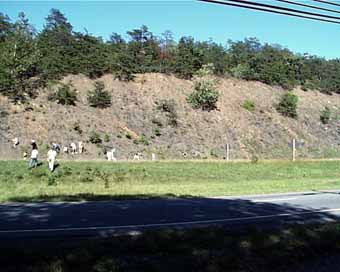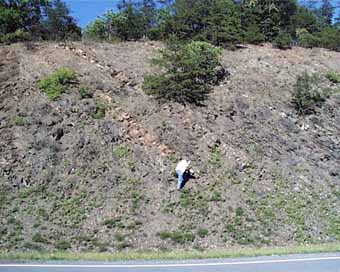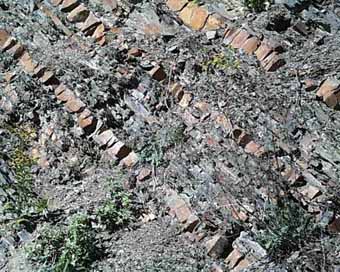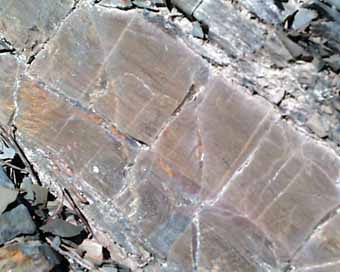
 With this stop we begin with an overall picture of the outcrop and then hone in closer and closer with each picture. The thing we noticed at the distance of the top picture was that the outcrop consisted of interbedded sandstones and shales, and that the sandstones seemed to maintain thickness over their entire exposure.
With this stop we begin with an overall picture of the outcrop and then hone in closer and closer with each picture. The thing we noticed at the distance of the top picture was that the outcrop consisted of interbedded sandstones and shales, and that the sandstones seemed to maintain thickness over their entire exposure.
To the right we see a somewhat closer view, and here we discussed the presence of parasequences in the outcrop. Turbidie parasequences are cycles of thinning/fining upward sandstones. That can be detected in the picture to the right.
|
 In this image we can see the interbedded nature of the sandstones and shales, but we are really not close enough to detect any of the Bouma structures we detected on the outcrop.
In this image we can see the interbedded nature of the sandstones and shales, but we are really not close enough to detect any of the Bouma structures we detected on the outcrop.
|
 Pictures just do not substitute for the real thing, and even here we cannot easily see the individual Bouma units. But they are there. We mostly say Tcde's, which are midfan type sequences. Occasionally Ta and Tb units show up to but they are decidedly rarer.
Pictures just do not substitute for the real thing, and even here we cannot easily see the individual Bouma units. But they are there. We mostly say Tcde's, which are midfan type sequences. Occasionally Ta and Tb units show up to but they are decidedly rarer.
|
 In this ultra close up we finally can detect some cross laminations of the Tc unit, although in fact most of the sandstone float fragments you pick up exhibit them very well. Notice that the bottom of this sandstone (left side) is scoured and we are probably looking at a flute mark.
In this ultra close up we finally can detect some cross laminations of the Tc unit, although in fact most of the sandstone float fragments you pick up exhibit them very well. Notice that the bottom of this sandstone (left side) is scoured and we are probably looking at a flute mark.
|
|

